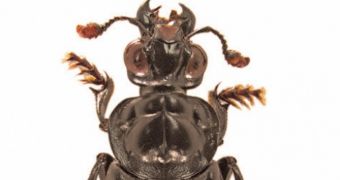A new species of burying beetle has recently been discovered by scientists. Interestingly enough, the species was identified as a self-standing one with the help of 6 specimens that have spent more than four decades tucked away at the Bishop Museum in Hawaii.
Burying beetles are relatively big, and sport black and red patterns on their backs.
What makes them stand out amongst other species of insects is the fact that, when the time comes for them to reproduce, they bury small vertebrate carcasses in the ground.
When their offspring emerge, they get to feed on these carcasses while both mom and dad stand by and guard over them, sources say.
Tonys Mousseau, who came across these six specimens and first suspected that they were representatives of a previously undocumented species, said that, “Without my background and training in the taxonomy of beetles, particularly the burying beetles, this new species might never have been uncovered.”
“It was a bit of good luck that led to our realization these specimens belonged to an undescribed species,” Dr. Sikes of the University of Alaska Museum also pointed out.
The new species is now referred to by the scientific community as Nicrophorus efferens.

 14 DAY TRIAL //
14 DAY TRIAL //